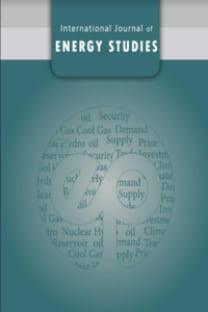Experimental Investigation of The Performance of CuO - Graphene Nanoplatelet / Water Hybrid Nanofluid in Concentric Tube Heat Exchanger
Hybrid nanofluid, Concentric tube heat exchanger Heat transfer enhancement, Parallel flow,
___
- [1] Turkoglu, S., P., Kardogan, P. “The Role and Importance of Energy Efficiency for Sustainable Development of the Countries”, 3rd International Sustainable Buildings Symposium (ISBS) United Arab Emirates, 2017, 53-60.
- [2] Kanojiya, N., Kriplani, V., Walke, P. “Heat Transfer Enhancement in Heat Exchangers With Inserts: A Review”, International Journal of Engineering Research & Technology 2014: 3(10).
- [3] Monjurul Ehsan, M., Noor, S., Salehin, S., Sadrul Islam, A. “Application of Nanofluid in Heat Exchangers for Energy Savings”, Thermofluid Modeling for Energy Efficiency Applications, Academic Press, 2016,73-101.
- [4] Alosious, S., R, S., Nair, A. and Krishnakumar, K. (2017). Experimental and numerical study on heat transfer enhancement of flat tube radiator using Al2O3 and CuO nanofluids. Heat and Mass Transfer, 53(12), 3545-3563.
- [5] Bin-Abdun, N., Razlan, Z., Shahriman, A., Voon, C., Wan, W., Zunaidi, I., Albzeirat, M. and Rani, M. (2018). The Comparison between the Performance of Water and CuO/Water nanofluid in Improving the Heat Transfer of Small Spaces. IOP Conference Series: Materials Science and Engineering, 429, 012073.
- [6] Chavda, N. (2015). Effect of Nanofluid on Heat Transfer Characteristics of Double Pipe Heat Exchanger: Part-II: Effect of Copper Oxide Nanofluid. International Journal of Research in Engineering and Technology, 04(04), 688-696.
- [7] Arshad, A., Jabbal, M., Yan, Y. and Reay, D. (2019). A review on graphene based nanofluids: Preparation, characterization and applications. Journal of Molecular Liquids, 279, 444-484.
- [8] Alshikhi, O. and Kayfeci, M. (2020). Experimental investigation of using graphene nanoplatelets and hybrid nanofluid as coolant in photovoltaic PV/T systems. Thermal Science, 00, 348-348.
- [9] Variyenli, H. İ. (2019). Experimental and Numerical Investigation of Heat Transfer Enhancement In A Plate Heat Exchanger Using A Fly Ash Nanofluid. Heat Transfer Research, 50(15), 1477-1494.
- [10] Sozen, A., Variyenli, H., Ozdemir, M., Guru, M. and Aytac, I., 2016. Heat transfer enhancement using alumina and fly ash nanofluids in parallel and cross-flow concentric tube heat exchangers. Journal of the Energy Institute, 89(3), pp.414-424.
- Yayın Aralığı: Yılda 4 Sayı
- Başlangıç: 2016
- Yayıncı: Türkiye Enerji Stratejileri ve Politikaları Araştırma Merkezi (TESPAM)
The Model of “Free Investment & Centralised Management” in Renewable Energy Production Projects
Selman DEMİRKESEN, Halil VARİYENLİ
Abdullah DAĞDEVİREN, Bahadir ACAR, Murat AYDIN
Selman DEMİRKESEN, Halil VARİYENLİ
Bahadir ACAR, Abdullah DAĞDEVİREN, Ahmed JANAANİ, Khandan ROSHANAEI, Edip TAŞKESEN, Göknur KAYATAŞ ONGUN, Mehmet ÖZKAYMAK
